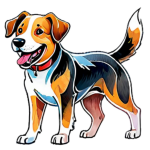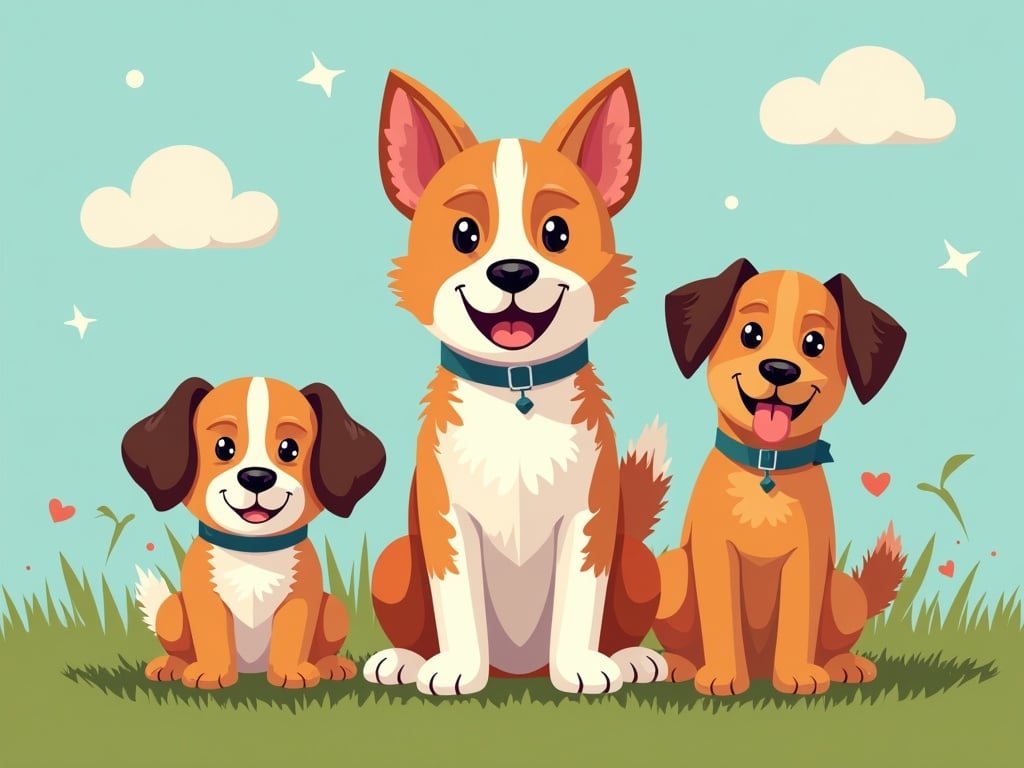Understanding Different Dog Play Styles: A Comprehensive Guide
Have you ever watched dogs playing in a park and wondered what's really going on? What looks like a chaotic tumble of fur and teeth to the untrained eye is actually a complex dance of communication, negotiation, and social interaction. Understanding the nuances of dog play styles isn't just interesting; it's crucial for responsible dog ownership, helping you ensure your furry friend is having a positive and safe experience. Not all play is created equal, and recognizing the differences can prevent potential squabbles and foster happier, healthier canine relationships.
The Importance of Recognizing Dog Play Styles
Why bother learning about dog play styles? Because misinterpreting play can lead to problems. What one dog considers a fun wrestling match, another might perceive as an aggressive threat. Understanding the subtle signals and behaviors of different play styles allows you to:
**Prevent fights:Intervene early if play escalates or becomes one-sided.
**Choose appropriate playmates:Match your dog with others who share similar play styles.
**Reduce anxiety: Knowing what to expect can help calm a nervous dog in social situations.
**Strengthen your bond: Understanding your dog's preferences shows you care and builds trust.
**Advocate for your dog: Ensure your dog's needs are met and that they are comfortable and safe during playtime.
Common Dog Play Styles: A Detailed Look
Dogs, just like people, have diverse personalities and preferences. This translates into a variety of play styles. Here are some of the most common:
1. The Wrestler
These dogs love physical contact. Their play often involves:
**Body slams and bumps: Using their weight to playfully knock each other over.
**Mouthy play: Nipping, mouthing, and gentle biting (without breaking skin).
**Tackling: Running head-on and using their bodies to stop another dog.
**Dominance displays: Humping (not always sexual), standing over another dog.
It's important to differentiate between playful wrestling and aggression. Look for relaxed body language, play bows (a bowing posture indicating playful intent), and reciprocal behavior – taking turns being on top or initiating the play.
2. The Chaser/Chasee
This is classic tag, you're it! play. Chasers love to run after other dogs, while chasees enjoy the thrill of being pursued. Key characteristics include:
**High-speed running: Often full-out sprints across open spaces.
**Circling: Running in loops and figure eights.
**Exaggerated movements: Leaping and bounding.
**Vocalization: Excited barks and yips.
Problems arise when one dog always chases and the other always runs, leading to exhaustion or fear in the chasee. Encourage role reversal and ensure both dogs have opportunities to be both the chaser and the chased.
3. The Boxer
Think of these dogs as playful pugilists. Their repertoire includes:
**Paw swipes: Using their paws to bat at another dog's face or body.
**Playful growling: Making guttural noises that sound intimidating but are part of the game.
**Dancing: Moving from side to side, feinting and dodging.
**Exaggerated facial expressions: Showing their teeth in a playful snarl.
Boxers require a tolerant playmate who understands their style isn’t aggressive. Carefully monitor the other dog's body language to ensure they're comfortable with the boxing behavior.
4. The Toy Player
These dogs are all about the object. Their play revolves around:
**Fetching: Retrieving balls, frisbees, or other toys.
**Tug-of-war: Pulling on a rope or toy.
**Possession: Guarding a toy from other dogs (this requires careful management to prevent resource guarding issues).
**Sharing (or not sharing): Some toy players happily share, while others are possessive.
When multiple toy players are involved, introduce multiple toys to minimize competition. Supervise carefully to prevent conflicts over resources.
5. The Vocalizer
These dogs are the talkers of the dog world. Their play is characterized by:
**Excessive barking: Constant barking during play.
**Whining: High-pitched vocalizations.
**Growling: Playful growls mixed with happy sounds.
**Yipping: Short, sharp barks.
While vocalization is a normal part of dog play, excessive barking can be disruptive to other dogs and people. It's crucial to teach your dog a quiet command and to redirect their attention if their vocalizations become overwhelming.
Decoding Dog Body Language: Telling the Difference Between Play and Aggression
Understanding dog body language is essential for differentiating between playful interaction and potential aggression. Here are some key indicators to watch for:
Signs of Playful Behavior:
**Play bow: A lowered front end with a raised rear, signaling I'm just playing!
**Loose body posture: Wagging tail, relaxed muscles, soft eyes.
**Open mouth: Often with a playful grin.
**Reciprocal behavior: Taking turns chasing, wrestling, or being on top.
**Self-handicapping: One dog allowing the other to win occasionally.
Signs of Aggression or Discomfort:
**Stiff body posture: Tense muscles, rigid tail.
**Hard stare: Direct, unwavering eye contact.
**Raised hackles: Hair standing up along the back.
**Snarling or snapping: Showing teeth aggressively.
**Lip licking or yawning (when not tired): Signs of stress or anxiety.
**Tail tucked between legs: Sign of fear or submission.
**Moving away or trying to escape: Indicating discomfort or a desire to end the interaction.
If you observe any signs of aggression or discomfort, immediately separate the dogs and redirect their attention to a different activity.
How to Facilitate Positive Play Experiences
Creating a safe and enjoyable play environment for your dog involves careful planning and supervision. Here are some tips:
**Choose appropriate playmates: Match dogs with similar energy levels and play styles. Avoid pairing a high-energy wrestler with a shy, timid dog.
**Start slow: Allow dogs to greet each other in a controlled environment, such as on leash, before unleashing them for free play.
**Supervise closely: Always monitor dog play and be ready to intervene if necessary.
**Provide breaks: Give dogs opportunities to rest and cool down during play sessions. Overstimulation can lead to aggression.
**Create a safe environment: Ensure the play area is free of hazards, such as sharp objects or busy roads.
**Teach basic commands: Commands like leave it, come, and stay can be invaluable for managing dog interactions.
**Respect your dog's limits: If your dog is showing signs of stress or discomfort, remove them from the situation immediately.
**Consider professional guidance**: If you’re unsure about your dog’s socialization skills or how they interact with other dogs, consulting with a certified dog trainer or behaviorist can provide valuable insights and personalized advice.
The Role of Breed in Play Style
While individual personalities play a significant role, certain breeds are predisposed to certain play styles. This is due to their historical roles and inherent traits.
**Herding breeds (e.g., Border Collies, Australian Shepherds):Often exhibit chasing and nipping behaviors, reflecting their instinct to herd livestock.
**Terriers (e.g., Jack Russell Terriers, Fox Terriers):Tend to be high-energy and enjoy wrestling, digging, and chasing.
**Retrievers (e.g., Labrador Retrievers, Golden Retrievers):Typically enjoy fetching and retrieving toys.
**Guard dogs (e.g., German Shepherds, Rottweilers):May be more protective and less tolerant of rough play. It's important to note that breed is just one factor, and individual dogs within a breed can vary significantly.
When to Intervene: Recognizing Unhealthy Play
Knowing when to step in and interrupt dog play is crucial for preventing escalation and ensuring everyone's safety. Here are some scenarios that warrant intervention:
**One-sided play: If one dog is constantly being chased, wrestled, or harassed by another, the play is no longer fun for them.
**Bullying behavior: One dog consistently dominating the other, preventing them from accessing resources or participating in play.
**Escalated aggression: Growling, snapping, or biting.
**Fear or anxiety: One dog showing signs of fear, such as tail tucking, lip licking, or trying to escape.
**Excessive vocalization: Constant, high-pitched barking or screaming.
**Fatigue:One or more dogs becoming overly tired, increasing the risk of irritability.
When intervening, use a calm and assertive voice. Avoid yelling or getting physically involved, as this can escalate the situation. Simply separate the dogs and redirect their attention to a different activity.
Beyond the Dog Park: Alternative Socialization Opportunities
Dog parks aren't the only place for socialization. Consider these alternatives:
**Leashed walks: Allowing your dog to greet other dogs on leash in a controlled environment.
**Obedience classes: Providing opportunities for controlled interaction and socialization.
**Small playgroups: Arranging playdates with a few carefully selected dogs.
**Doggy daycare: Offering structured socialization in a supervised setting.
**Hiking:Allows dogs to explore the environment together and have shared experiences.
**Training session:Training together can create a strong bond, while also socializing them to a new environment.
Ultimately, understanding different dog play styles empowers you to be a better advocate for your furry friend. By carefully observing, interpreting body language, and creating safe play environments, you can help your dog develop positive social skills and enjoy enriching interactions with other canines. So, the next time you see a group of dogs playing, take a moment to appreciate the fascinating communication and social dynamics unfolding before your eyes. You'll not only gain a deeper understanding of your own dog but also a greater appreciation for the wonderful world of canine interaction.


